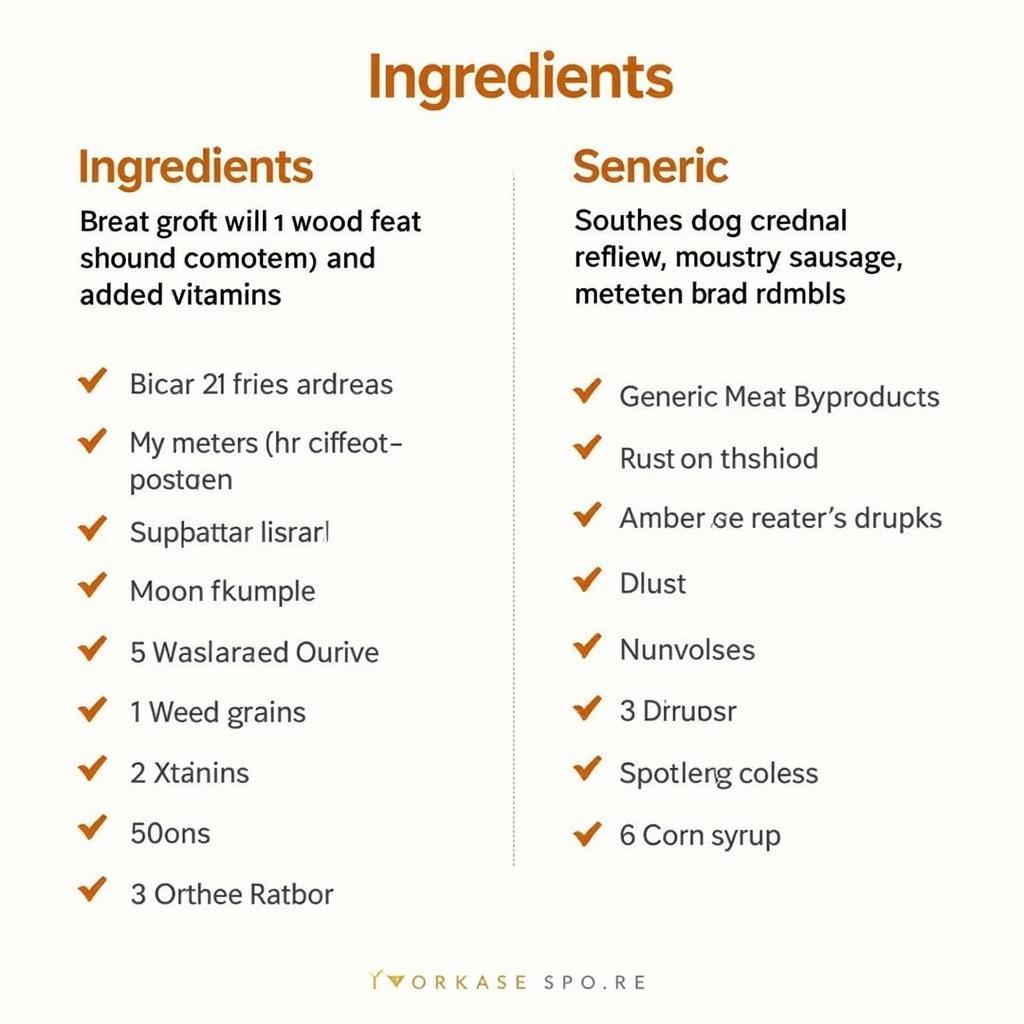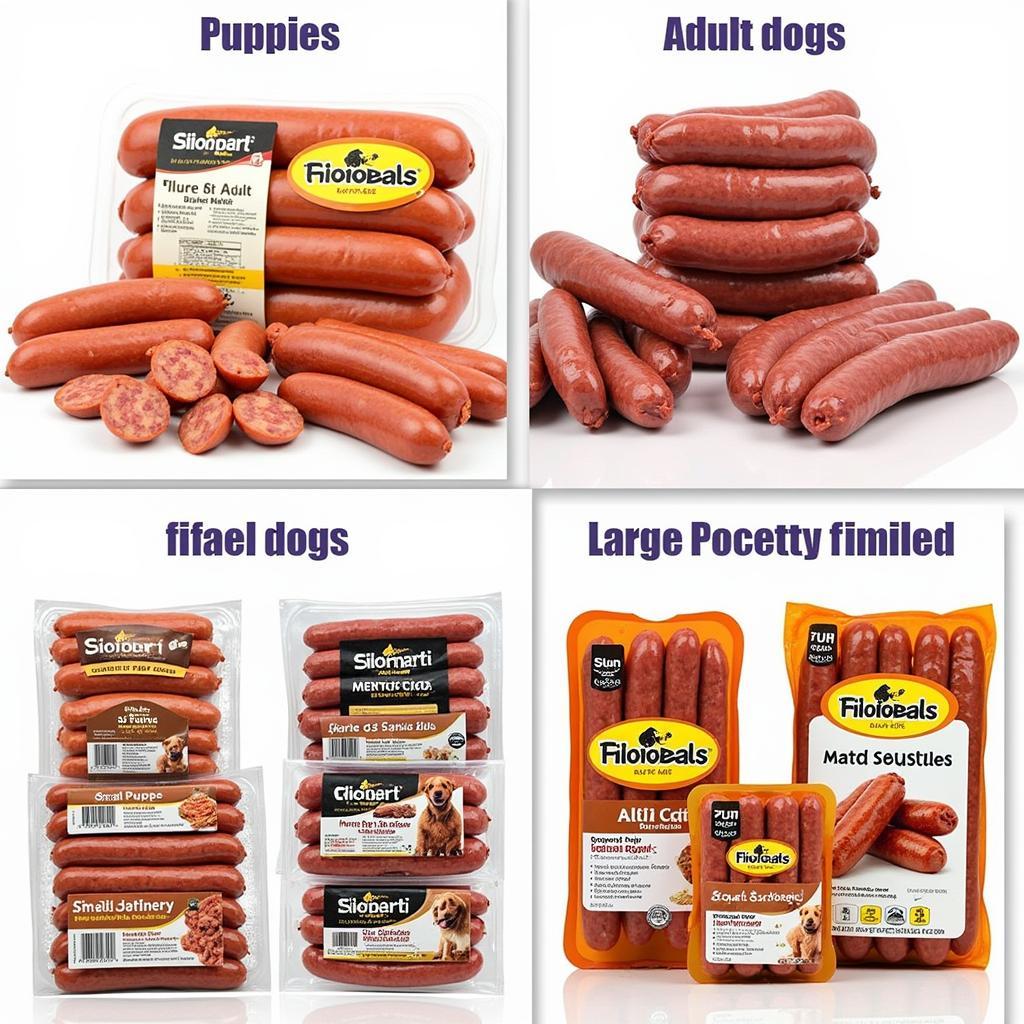Dog Food Sausage has become increasingly popular in recent years, offering a convenient and often appealing way to feed our furry friends. But what exactly is dog food sausage, and is it a healthy option for your canine companion? This comprehensive guide explores everything you need to know about dog food sausage, from its ingredients and benefits to potential drawbacks and how to choose the best option for your pet.
Understanding Dog Food Sausage: More Than Just a Tasty Treat
Dog food sausage typically comes in a long, cylindrical shape, resembling traditional breakfast sausage but formulated specifically for dogs. It’s often made with a blend of meats, grains, vegetables, and added vitamins and minerals to provide a nutritionally complete and balanced diet.
While dry kibble remains the most common type of dog food, sausage offers several advantages:
- Palatability: The soft, chewy texture and savory flavors can be particularly enticing for picky eaters or dogs with dental issues that make chewing kibble difficult.
- Convenience: Dog food sausage often comes in pre-portioned links, making it easy to serve and reducing mess and waste. This is especially helpful for busy pet parents or those who travel frequently with their dogs.
- Hydration: Some dogs don’t drink enough water, which can lead to dehydration. Dog food sausage generally has higher moisture content than dry kibble, contributing to your dog’s overall hydration.
 Dog Enjoying Sausage
Dog Enjoying Sausage
Decoding the Ingredient List: What Makes a Good Dog Food Sausage?
Not all dog food sausages are created equal. Just like any other type of pet food, the quality of ingredients can vary significantly between brands and recipes. Here’s what to look for:
High-Quality Protein Sources: Meat should be the primary ingredient, providing essential amino acids for muscle growth and overall health. Look for named meat sources like chicken, beef, fish, or lamb, rather than generic terms like “meat by-products.”
Wholesome Grains, Fruits, and Vegetables: While not strictly necessary for all dogs, some grains, fruits, and vegetables can provide valuable nutrients, fiber, and antioxidants. Choose products with whole grains like brown rice or oats and recognizable fruits and veggies.
Added Vitamins and Minerals: Essential nutrients like vitamins A, D, E, and K, as well as minerals like calcium and phosphorus, are crucial for your dog’s overall well-being.
Avoid Artificial Ingredients: Artificial colors, flavors, and preservatives can be potentially harmful to dogs. Opt for brands that use natural preservatives like vitamin E.
Check for AAFCO Statement: The Association of American Feed Control Officials (AAFCO) sets nutritional standards for pet food. Look for a statement on the packaging that says the food is “complete and balanced” for your dog’s life stage.
 Dog Food Sausage Ingredients Chart
Dog Food Sausage Ingredients Chart
Potential Drawbacks of Dog Food Sausage: What to Consider
While dog food sausage can be a healthy and convenient option for many dogs, there are some potential drawbacks to keep in mind:
Higher Cost: Dog food sausage tends to be more expensive than dry kibble, especially for high-quality brands.
Shorter Shelf Life: Due to its higher moisture content, dog food sausage can spoil more quickly than dry kibble. It’s crucial to store it properly in the refrigerator and follow the manufacturer’s recommendations for use.
Mess Potential: While generally less messy than wet food, dog food sausage can still be a bit messy, especially for enthusiastic eaters.
Dental Health: While the soft texture can be beneficial for some dogs, it may not be ideal for all. Chewing on hard kibble can help clean teeth and prevent tartar buildup, so it’s essential to consider your dog’s individual dental needs.
Choosing the Right Dog Food Sausage: Factors to Consider
With so many options available, selecting the best dog food sausage for your furry friend can feel overwhelming. Here are some factors to consider:
Life Stage: Puppies, adult dogs, and senior dogs have different nutritional needs. Choose a product formulated for your dog’s specific life stage.
Breed Size: Small, medium, and large breeds may benefit from different kibble sizes and formulas.
Activity Level: Active dogs require more calories than sedentary dogs. Consider your dog’s activity level when choosing a food.
Health Conditions: If your dog has any health conditions, such as allergies, sensitivities, or digestive issues, talk to your veterinarian about the best food options.
Taste Preferences: Just like humans, dogs have individual taste preferences. Some dogs prefer beef, while others prefer chicken or fish.
 Variety of Dog Food Sausages
Variety of Dog Food Sausages
Incorporating Dog Food Sausage into Your Dog’s Diet
Dog food sausage can be fed as a complete and balanced meal, a tasty topper for kibble, or a special treat. Always follow the feeding guidelines on the packaging and consult your veterinarian if you have any concerns about your dog’s diet.
Transitioning to Dog Food Sausage: If you’re switching your dog to a new food, it’s essential to do so gradually. Start by mixing a small amount of the new food with your dog’s current food and gradually increase the ratio over several days to avoid digestive upset.
Storage and Handling: Always store dog food sausage in the refrigerator and discard any unused portions after the recommended time. Wash your hands thoroughly after handling pet food.
Frequently Asked Questions About Dog Food Sausage
Q: Can I feed my dog dog food sausage every day?
A: Yes, dog food sausage can be fed as a complete and balanced meal, provided it meets AAFCO standards for your dog’s life stage.
Q: What is the best way to store dog food sausage?
A: Store dog food sausage in the refrigerator and follow the manufacturer’s recommendations for use and storage.
Q: Can puppies eat dog food sausage?
A: Yes, there are dog food sausages specifically formulated for puppies’ nutritional needs.
Q: What if my dog doesn’t like dog food sausage?
A: Every dog has unique preferences. If your dog doesn’t like one type or brand of dog food sausage, try experimenting with different flavors or brands until you find one they enjoy.
Q: Is dog food sausage safe for dogs with allergies?
A: If your dog has food allergies, it’s crucial to choose a dog food sausage that is free from those specific ingredients. Look for hypoallergenic options or consult your veterinarian for recommendations.
Conclusion
Dog food sausage can be a healthy, convenient, and appealing option for many dogs. By understanding the ingredients, benefits, and potential drawbacks, and choosing a high-quality product that meets your dog’s individual needs, you can provide your furry friend with a delicious and nutritious diet they’ll love.
If you’re considering incorporating dog food sausage into your dog’s diet, be sure to consult your veterinarian for personalized recommendations.
For further insights into dog nutrition and delicious, healthy options, check out our articles on hot diggity dog food truck and roller grill food items.
Need assistance in navigating the world of dog food sausage or have specific questions about your furry friend’s dietary needs? Our dedicated team is here to help! Reach out to us at:
Phone Number: 02437655121
Email: [email protected]
Address: 3PGH+8R9, ĐT70A, thôn Trung, Bắc Từ Liêm, Hà Nội, Việt Nam
We have a 24/7 customer support team ready to assist you.